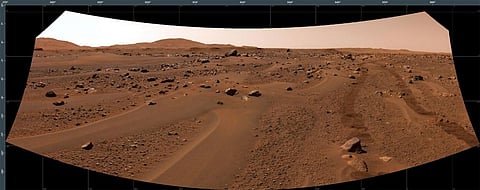

A seasonal imbalance of the ratio of solar energy absorbed by Mars and heat released by the planet into space may be fuelling dust storms in the red planet, according to a new study.
The ratio, known as energy budget, goes out of balance in the spring and summer seasons of red planet’s southern hemisphere, the report published in PNAS said. The resultant dust storms cover areas as large as continents on Earth and last for weeks, it added.
The storms are so intense that they’ve been captured by Earth’s telescopes, according to the National Aeronautics and Space Administration (NASA).
Energy excess (when the planet absorbs more energy than it emits) can be one of the drivers of Mars’ dust storms, Ellen Creecy, a PhD student at the University of Houston and the study’s lead author, said in a statement.
Earth has an energy budget, too. Therefore, Mars’ energy budget might provide clues about the role Earth’s energy budget plays in developing severe storms, including hurricanes, Creecy explained.
Creecy and colleagues analysed data on Mars’ orbits and temperatures from NASA’s missions between 1997 and 2005. This period equals four Martian years [MY], from MY 24 to 28.
The researchers calculated that the global average emitted power is around 111.7 watts per square metre on Mars.
But this varied during seasons. The energy excess in ‘northern autumn’, a southern hemisphere season, is roughly 15.3 per cent of the emitted energy.
This imbalance could affect the seasonal change of surface temperature on Mars, Liming Li, associate professor of physics and one of the study’s authors, told Down To Earth.
The researchers found a correlation between dust storms and emitted energy by comparing emitted energy in dust storm years and non-dust storm years on Mars.
In MY 25 (Earth year 2001), the daytime global emitted power dropped by around 22 per cent but nighttime emitted energy increased by 29 per cent. The same year, the planet experienced a dust storm.
Dust storms lift clouds of dust from the surface to the atmosphere, thereby changing the incoming solar energy and outgoing thermal energy, Li explained.
Therefore, Li added, the phenomenon probably also modifies the planet’s energy budget.
Exploring Mars’ radiant energy budget can provide clues to the planet’s weather and climate, as well as that of other planets. On Earth, the energy imbalance is 0.4 per cent of the emitted energy, Li added.
Li explained:
For the energy imbalance at longer time scales (more than one Earth year), Earth has a small energy imbalance (lesser than 0.1 per cent of the emitted thermal energy). Such an energy imbalance plays a critical role in global warming and climate change on Earth.
The atmospheric conditions of Mars are of interest since it is a candidate in our search for a habitable planet, Li added.
Recently, NASA’s Perseverance rover, which landed on Mars on February 18, 2021, began examining rocks from a former lake to search for clues on past life and ancient climate, according to news reports.
NASA aims to bring some rocks to Earth, where scientists can study them to learn about the red planet’s mysterious past.
Evidence suggests that Mars was once teeming with oceans and lakes. But no one knows why and when the planet transformed into the hot, dusty body that it is today, according to experts.
“Mars experienced global warming and climate change. We know that climate change is happening on Earth now. So, what do the lessons of Mars’ experience hold for the future of Earth?” Li said in a press statement.
The researchers are also investigating whether energy imbalance on Mars exists on a longer time scale, like on Earth.